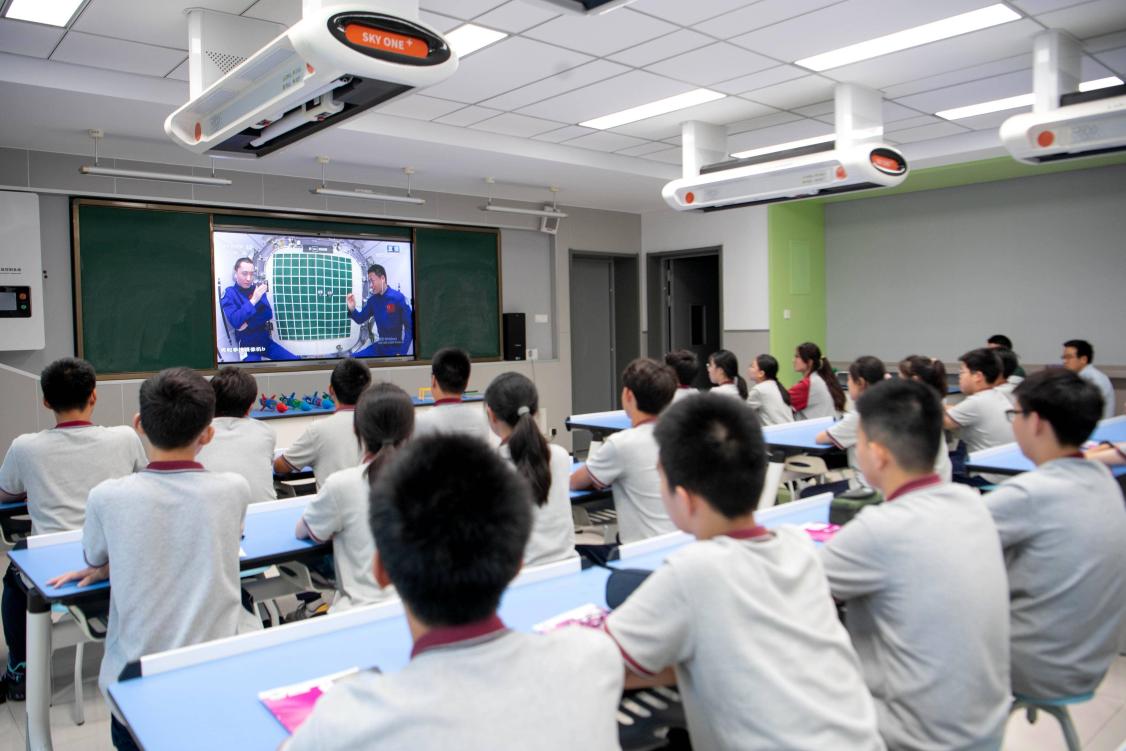




- BRNN
- BRI News
- BRNN News
- Database
Official Documents Polices and Regulations
Inter-government Documents International Cooperation BRI Countries
Business Guide Economic Data BRI Data
Trade
Investment Projects Latest projects
Cases - Content Pool

Students of a middle school in Zhang jiagang, east China's Jiangsu province attend a science lesson live-streamed by the Shenzhou-16 crew from the Tiangong Space Station, Sept. 21, 2023. (Photo/Ren Guangzhen)
On Dec. 31, 2022, Chinese President Xi Jinping solemnly declared in his 2023 New Year Address that "China's space station was fully completed."
Today, the space station has been operating smoothly and safely for more than 1,000 days. It has accommodated seven astronaut crews and facilitated over 200 space science and application projects, showcasing China's strength of self-reliance and independent innovation in science and technology.
This scene inside the space station is common: astronauts floating to the center of the cabin to do a stylish pull-up using ceiling handrails, riding the space bicycle, or running on the treadmill. The station is equipped with a dedicated exercise area to help astronauts maintain muscle strength and reduce the impact of long-term microgravity exposure on the body.
Over the past 1,000 days, the space station's environment and facilities have been continuously improved. Equipment such as fitness devices have been regularly delivered to the space station.
According to Tang Yi, a researcher from the ground support team of the space station and the China Academy of Space Technology, China's space station uses the latest generation of commercial wireless communication technology to ensure stable and seamless communication both inside and outside the cabin.

Astronauts of the Shenzhou-20 crew conduct extravehicular activities, Aug. 15, 2025. (Photo from the website of the China Manned Space)
"To help astronauts sleep better, we replaced the doors of the sleeping area," said Tang. "The new doors use improved materials, structure, and locking design, achieving better sound and light insulation."
The space station is also home to a unique group of "AI crewmates". AI assistants such as the Wukong AI large language model, pipeline inspection robots, and Xiaohang robot provide intelligent and specialized support for astronauts in orbit.
Tang noted that in the next 1,000 days, the team hopes to introduce more advanced scientific and technological innovations to further enhance the station's intelligence and autonomy, enabling it to better support astronauts' work and life in space.
The space station serves scientific application, and scientific experiments are carried out in it every day.
Astronauts have taken video footage of sprouting Arabidopsis seedlings to study how microgravity affects plant cell structure and function. They also conduct experiments on brain organoid chips to explore how the space environment impacts human brain health.

Children watch a scaled-down model of China's space station in Chuzhou, east China's Anhui province. (Photo/Lyu Hua)
According to Guo Xiaoxiao, deputy director of the application office at the Technology and Engineering Center for Space Utilization of the Chinese Academy of Sciences, space science and application projects can be broadly categorized into three areas: scientific research in fields such as space life science and biotechnology, space materials science, microgravity fundamental physics, microgravity fluid physics and combustion, and new spacecraft technologies; emerging scientific projects featuring innovation and frontier exploration; and application-oriented payload missions.
"Overall, these experimental projects have progressed very smoothly," said Guo. "In some areas of fundamental science, the results have even exceeded scientists' expectations, bringing many surprises."
Beyond the orbiting space station, there are actually two more "space stations" on Earth.
One is an identical ground-based version built by China Aerospace Science and Technology Corporation to enable full technical validation for the station's design, construction, and in-orbit operation, providing essential support for the real space station.
The other is a "digital space station" that offers simulation and verification support through pre-mission simulation, in-mission digital co-flight, and post-mission status evaluation.
Together, these three elements — the space-based, ground-based, and digital systems — form an integrated operational framework, providing robust support for the long-term, stable operation of China's space station.
Tang explained that the ground support team continues to maintain an "around-the-clock, 365 days × 24 hours" standby mode, responsible for data monitoring, trend analysis, mission support, and troubleshooting.
Looking to the next 1,000 days, leveraging the role of the space station as a "space home port" will be an important direction of exploration.
The station has unique advantages — abundant resources, continuous human presence, and a high level of intelligence, said Tang. By developing standardized service models and interfaces, and providing in-orbit services for various types of spacecraft, China's space station is poised to embrace even broader prospects for development.

Tel:86-10-65363107, 86-10-65368220, 86-10-65363106